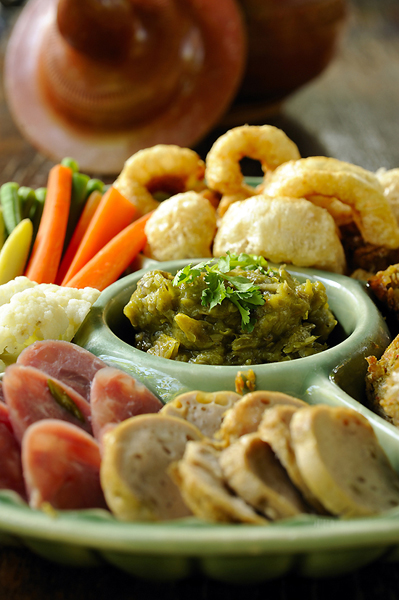
| ||||||||||||
|
||||||||||||
Northern Thai CuisineThai food varies from region to region due to geography and history. In the West, most Thai restaurants serve Bangkok-style cuisine, so travelling in Thailand is a culinary adventure of discovery. Lanna-style cuisine comes from the mountainous area of the country, where the winter months are much cooler then anywhere else in Thailand, with some regions even reaching freezing temperatures on the mountain tops! The region is abundant with wild mushrooms, forest vegetables and fruits and wildlife which all feature in this less well-known regional cuisine of Thailand.
Typical Foods of Northern Thailand:
The North of Thailand is mountainous and more temperate than the rest of the country, with slightly cooler weather year-round. Its location near China and Burma has made the North a trading center and a crossroads for culture and people like the Tai, Burmese, Chinese and many various hill tribes who all brought their own foods and cooking styles. The food of the North (Lanna) is characterized by this abundance of flavors and influences, with many typical foods tracing their origins to a number of different cuisines. The North's historical isolation, thanks to its mountainous terrain, allowed its cuisine to develop uniquely from that of Bangkok and the rest of Thailand. One of the most notable characteristics of Lanna food is that it is not spicy and even somewhat bland or sweet in flavor. Khao Soi, Chiang Mai's famous noodle-and-curry soup, may have originated with the Burmese Shan or the Chinese Muslim Yunnan, and the name Khao Soi itself illustrates its mix of possible sources. Khao Soi literally means 'enter the lane,' and might refer to the location of the stands where this dish was introduced – run by traders from Yunnan – on tiny side streets. There is, though, also a Burmese noodle dish with a similar name and composition. As parts of the North were controlled by Burma for hundreds of years, it is understandable that these foods would share some similarities. Khao Soi blends a thick curry base with fresh Chinese noodles, dried spices and coconut milk made from coconuts from the South of Thailand (which were uncommon here, as the Northern climate is too cold for them to grow in abundance). Thanks to this history of “fusion” food, the North has the widest variety of noodle dishes in Thailand, with Khao Soi being just one of them. Because the soil and the forests of the North are so fertile, this regional cuisine is characterized by an abundance of foods that can be grown there. These favorable agricultural conditions may have resulted in Northern food not being as spicy as the other regions of Thailand (esp. Issan) as it wasn't necessary to encourage diners to eat more rice, and less meat or vegetables, by adding lots of chili spice. The predominant flavors in Northern food are hot and salty, with the heat coming from chilies, fresh ginger and galangal, fresh or dried black pepper and long pepper (Piper longum). The salty taste is traditionally derived from a number of assertive seasoning pastes pounded from fermented soybeans, fish (usually fermented, plah rah) and salted land crabs. Northern people also use bitter or astringent forest herbs which are indiginous to the region. Because the raising of pigs has always been part of the Northern Thai farm, there has traditionally been an abundance of pork fat available for rich, oily dishes and for deep-frying. In addition, forests full of wood have provided plenty of fuel for adapting slow cooking methods like roasts and braises, as well as for grilling, frying and boiling. Curries and soups in the North tend to be simply prepared and long-boiled. Chinese-influenced Northern dishes, on the other hand, are subject to a rapid, very hot stir-fry. Freshwater fish like catfish and eels are common, as are game meats like wild boar, deer and frog. Small sour cherry tomatoes, young tamarind leaves, young green mango and bamboo shoots are typical vegetables. Jackfruit is an important staple ingredient and is eaten both sweet and ripe as a fruit, and young and starchy as a vegetable. Sticky rice is the favored staple grain as it also is in the neighboring Isan region. Image © 2012 shutterstock.com/erkanupan
Welcome to the Temple of Thai-online Asian food! Convenient online shopping for Thai food - shop for 100's of exotic ingredients like curry, tamarind paste, coconut milk, and fish sauce. Find fresh items including chili peppers, lemon grass and kaffir lime leaf. |
||||||||||||



